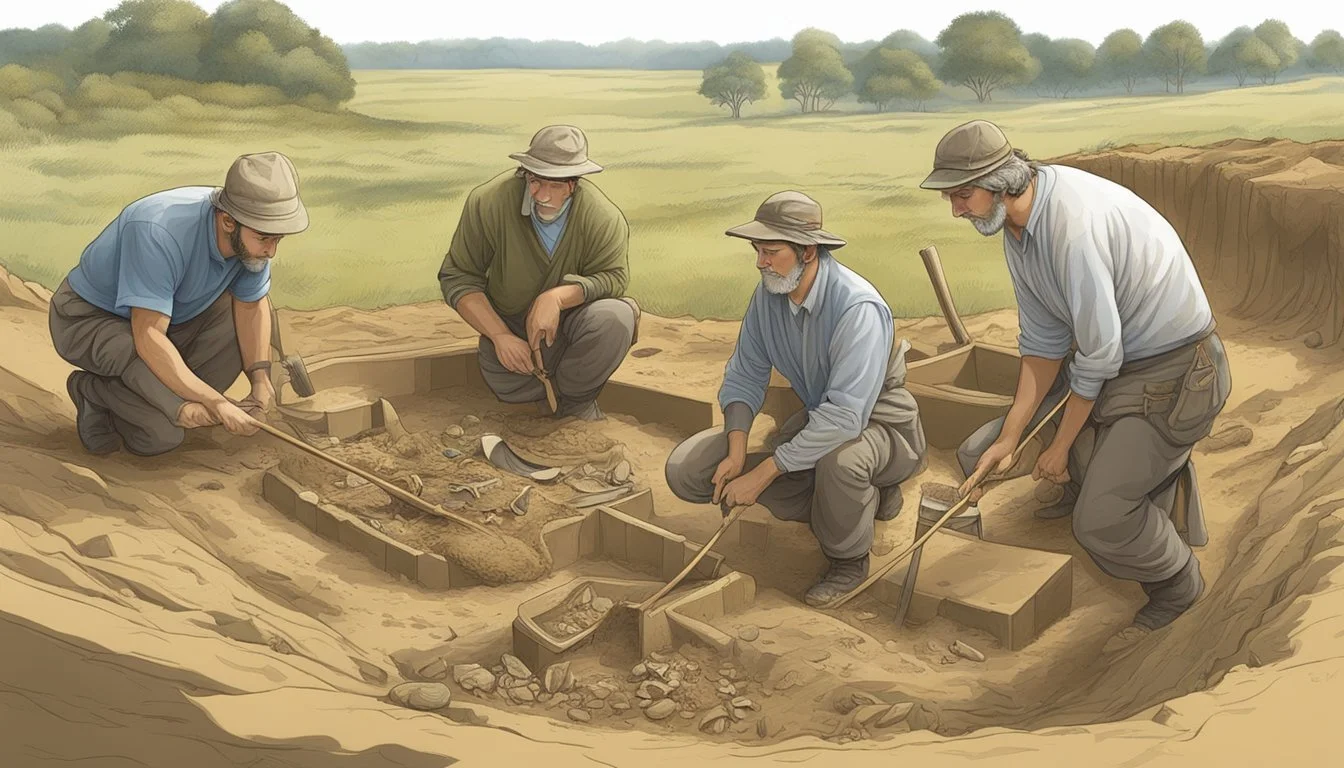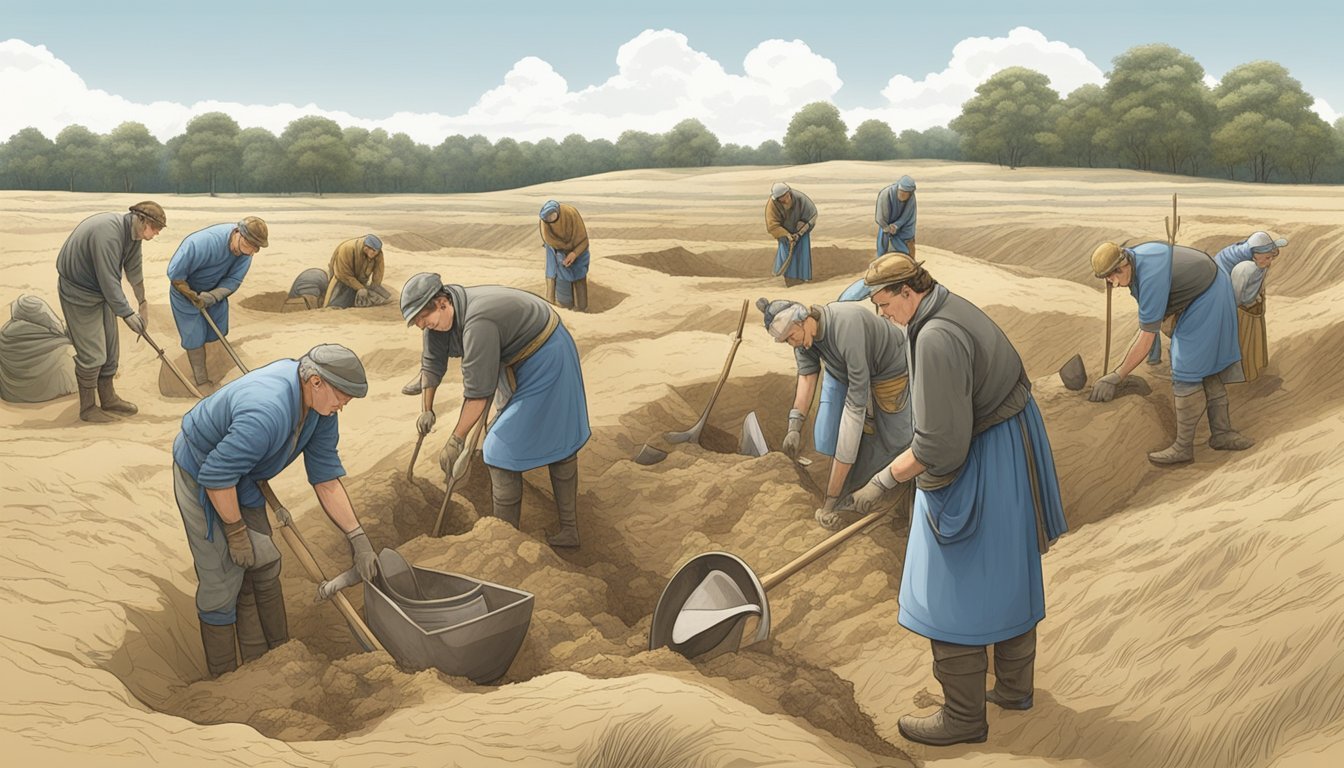Unearthing History: The Real Dig at Sutton Hoo
Revealing Anglo-Saxon Treasures
In 1939, a remarkable discovery unfolded on a quiet English estate in Suffolk. Landowner Edith Pretty hired archaeologist Basil Brown to investigate mysterious mounds on her property at Sutton Hoo. What they unearthed would revolutionize our understanding of Anglo-Saxon England.
The excavation revealed an intact ship burial containing a treasure trove of artifacts that shed new light on the so-called "Dark Ages." The find included exquisite gold and garnet jewelry, ceremonial weapons, and the iconic Sutton Hoo helmet. These objects demonstrated a level of craftsmanship and artistic sophistication previously unknown for 7th century Britain.
The Sutton Hoo excavation captured the public imagination and continues to fascinate decades later. Its story inspired John Preston's novel "The Dig" and the subsequent Netflix film adaptation. The discovery remains one of the most significant archaeological finds in British history, offering invaluable insights into early medieval culture, trade networks, and royal power.
The Historical Context of Sutton Hoo
Sutton Hoo's significance stems from its place in 7th century Anglo-Saxon England. The site provides crucial insights into the power dynamics and cultural practices of early medieval East Anglia.
Anglo-Saxon England and East Anglia
Anglo-Saxon England emerged after the withdrawal of Roman forces in the 5th century. Germanic tribes, including Angles, Saxons, and Jutes, migrated to Britain, establishing several kingdoms. East Anglia, formed by the Angles, became one of the most powerful Anglo-Saxon realms.
The 7th century marked a transitional period between paganism and Christianity in Anglo-Saxon society. This religious shift influenced art, burial practices, and political alliances across England.
East Anglia's strategic location facilitated trade with continental Europe, contributing to its wealth and cultural exchange. The region's prosperity is reflected in the rich artifacts found at Sutton Hoo.
The Kingdom of the East Angles and Rædwald
The Kingdom of the East Angles reached its zenith under King Rædwald's rule in the early 7th century. Rædwald, believed by many scholars to be the occupant of the Sutton Hoo ship burial, was a powerful figure in Anglo-Saxon politics.
Rædwald's reign bridged the pagan and Christian worlds. He maintained a pagan shrine while supporting Christianity, exemplifying the complex religious landscape of the time.
The Sutton Hoo burial, with its mixture of Anglo-Saxon and foreign artifacts, demonstrates East Anglia's connections to wider European trade networks. Items from as far as the Byzantine Empire highlight the kingdom's international reach.
Rædwald's political influence extended beyond East Anglia. He played a crucial role in Northumbrian succession disputes, showcasing the interconnected nature of Anglo-Saxon kingdoms during this period.
Discovery of Sutton Hoo
The discovery of Sutton Hoo in 1939 revolutionized our understanding of Anglo-Saxon England. This remarkable archaeological site unveiled a wealth of treasures and historical insights, shedding light on a period once known as the Dark Ages.
Edith Pretty and the Initial Discovery
Edith Pretty, the owner of the Sutton Hoo estate, sparked the initial discovery. Intrigued by the mysterious mounds on her property, she enlisted the help of local archaeologist Basil Brown in 1938. Pretty's curiosity and Brown's expertise proved to be a pivotal combination.
The first excavations focused on several smaller mounds. These initial digs yielded some artifacts, but the true magnitude of the discovery was yet to be revealed.
Basil Brown's Excavations
In 1939, Basil Brown began excavating the largest mound at Sutton Hoo. His meticulous work soon uncovered the outline of an 88-foot-long ship burial. This find was unprecedented in British archaeology.
As Brown carefully removed layers of soil, he exposed rivets and other ship remnants. The excavation also revealed exquisite artifacts, including gold and garnet jewelry, silver plates, and a distinctive helmet.
The significance of the discovery quickly became apparent. Archaeologists from across Britain, including Charles Phillips, joined the excavation.
The Role of the National Trust and Later Studies
The outbreak of World War II temporarily halted work at Sutton Hoo. The National Trust acquired the site in 1998, ensuring its long-term preservation and study.
Subsequent excavations have continued to yield new insights. In the 1960s and 1980s, archaeologist Martin Carver led extensive campaigns at the site. These studies revealed additional burials and expanded our understanding of the Sutton Hoo complex.
Today, Sutton Hoo remains a subject of ongoing research. Its treasures, now housed in the British Museum, continue to captivate scholars and the public alike.
The Sutton Hoo Ship Burial
The Sutton Hoo ship burial stands as one of the most significant archaeological discoveries in British history. This remarkable find unveiled a wealth of Anglo-Saxon artifacts and shed light on a pivotal period in medieval Europe.
Understanding Ship Burials in the Anglo-Saxon Era
Ship burials were a distinctive funerary practice among Anglo-Saxon elites. These rituals involved interring the deceased in a ship, surrounded by valuable possessions. The Sutton Hoo burial, dating to the 6th or 7th century A.D., represents the richest example of this tradition ever found in Europe.
The practice symbolized the deceased's journey to the afterlife. It also displayed the power and wealth of the individual and their community. Ship burials were rare, reserved only for the most prominent members of society.
Construction and Significance of the Ship
The Sutton Hoo ship measured an impressive 27 meters (88.6 feet) in length. Though the wood had long since decayed, the ship's outline was preserved in the soil. Archaeologists identified over 3,000 iron rivets, revealing the vessel's construction details.
The ship served as both a burial chamber and a symbol of the deceased's status. Inside, excavators discovered a treasure trove of artifacts, including weapons, jewelry, and ceremonial objects. These items provide invaluable insights into Anglo-Saxon craftsmanship and trade networks.
The burial's contents suggest it may have belonged to a king, possibly Raedwald of East Anglia. This connection elevates the site's historical significance, offering a rare glimpse into early English royalty.
The Treasure Trove
The Sutton Hoo excavation revealed a wealth of Anglo-Saxon artifacts, showcasing exquisite craftsmanship and cultural significance. The discovery provided crucial insights into early medieval artistry and trade networks.
Catalog of Artefacts Found at Sutton Hoo
The burial ship at Sutton Hoo contained over 200 remarkable objects. A magnificent gold and garnet sword belt stood out among the treasures. The iconic Sutton Hoo helmet, intricately decorated with animal motifs, became a symbol of Anglo-Saxon art.
Other notable finds included a large silver platter, ornate gold buckles, and delicate gold shoulder clasps. Weaponry featured prominently, with a pattern-welded sword, shield, and spears. Rare textiles and fur remnants offered glimpses into Anglo-Saxon clothing.
Everyday items such as combs, bowls, and drinking horns provided insights into daily life. The presence of Frankish coins and Byzantine silverware indicated far-reaching trade connections.
Gold and Garnet: Workmanship and Origins
The gold and garnet artifacts from Sutton Hoo displayed exceptional craftsmanship. Intricate cloisonné work adorned many pieces, with tiny cells of gold filled with cut garnets. This technique created stunning visual effects, particularly evident in the shoulder clasps and purse lid.
The origin of the garnets puzzled researchers. Analysis revealed they likely came from as far as India or Sri Lanka, demonstrating extensive trade networks. The goldwork showed influences from various cultures, including Celtic and Mediterranean styles.
The level of skill exhibited in these objects indicated the presence of highly specialized craftsmen. The finds highlighted the sophistication of Anglo-Saxon metalworking traditions and their ability to incorporate diverse cultural influences.
Cultural and Historical Impact
The Sutton Hoo discovery revolutionized our understanding of Anglo-Saxon England and its connections to the wider world. It shed light on the complex interplay between pagan traditions and emerging Christian influences during a pivotal period in British history.
Influence on Understanding of the Anglo-Saxon World
The Sutton Hoo excavation revealed a sophisticated Anglo-Saxon society with far-reaching trade networks. Artifacts found at the site included items from as far away as the Byzantine Empire, indicating strong links to Constantinople.
These treasures challenged the notion of a "Dark Age" following the Roman withdrawal from Britain. Instead, they painted a picture of a culturally rich and internationally connected Anglo-Saxon kingdom.
The grave goods also provided insights into Anglo-Saxon craftsmanship, artistic styles, and social hierarchies. The ornate gold and garnet jewelry, intricate metalwork, and high-quality textiles demonstrated advanced technological skills and aesthetic sensibilities.
Christianity and its Relationship with Pagan Traditions
Sutton Hoo offers a unique glimpse into the religious transition occurring in 7th-century England. The burial combines elements of pagan ship burial traditions with Christian symbolism.
Silver spoons inscribed with Christian names were found alongside items associated with Norse mythology. This blend suggests a period of religious coexistence and gradual conversion.
The presence of both pagan and Christian artifacts reflects the complex spiritual landscape of the time. It illustrates how early Anglo-Saxon rulers navigated between old beliefs and the new faith spreading across Europe.
The Sutton Hoo finds continue to inform our understanding of this crucial period in English religious history. They highlight the gradual nature of Christianization and the persistence of older traditions.
The Legacies of Sutton Hoo
The Sutton Hoo excavation left an indelible mark on archaeology and popular culture. Its treasures continue to captivate audiences through various media and educational initiatives.
Sutton Hoo in Modern Media
Netflix's film "The Dig" brought renewed attention to Sutton Hoo. Starring Carey Mulligan and Ralph Fiennes, the movie dramatized the 1939 excavation. It sparked public interest in the archaeological site and its history.
The iconic Sutton Hoo helmet has become a symbol of Anglo-Saxon England. It features prominently in documentaries and historical programs. The BBC has produced several shows exploring the significance of the Sutton Hoo finds.
Museums, including the British Museum, showcase Sutton Hoo artifacts. These exhibitions attract visitors from around the world. Virtual tours and online resources have made the treasures accessible to a global audience.
Sutton Hoo's Influence on Archaeology and Education
Sutton Hoo revolutionized understanding of Anglo-Saxon culture. It provided tangible evidence of sophisticated craftsmanship and trade networks. The discovery techniques used at Sutton Hoo influenced future archaeological practices.
Educational programs now incorporate Sutton Hoo into their curricula. Schools use the site to teach about history, archaeology, and conservation. The National Trust offers guided tours and workshops at the Sutton Hoo visitor center.
Research continues at Sutton Hoo, yielding new insights. Scientists apply modern technologies to analyze artifacts. These studies contribute to ongoing academic discussions about early medieval England.
Preservation and Presentation
The Sutton Hoo treasures have been carefully preserved and displayed for public appreciation. Efforts to conserve and exhibit these priceless artifacts involve multiple institutions and ongoing restoration work.
Museum Exhibitions and the Role of Ipswich Museum
Ipswich Museum played a crucial early role in showcasing the Sutton Hoo finds. It hosted temporary exhibitions of the artifacts shortly after their discovery, allowing local residents to view these remarkable pieces of history.
The British Museum in London became the permanent home for most of the Sutton Hoo treasures. Its Anglo-Saxon gallery features a dedicated space for the iconic helmet, gold buckle, and other significant items from the burial site.
Regular rotations of artifacts between storage and display help minimize light exposure and preserve delicate materials. The museum employs advanced conservation techniques to protect these irreplaceable objects for future generations.
Conservation Efforts and the Tranmer House
Tranmer House, located near the Sutton Hoo burial mounds, serves as a visitor center and exhibition space. The National Trust manages this property, which was donated by the Annie Tranmer Trust.
Conservation work at Sutton Hoo extends beyond the artifacts to the landscape itself. Careful management of the burial mounds prevents erosion and preserves the site's archaeological integrity.
The conservation team uses non-invasive techniques to monitor the condition of buried remains. This approach balances the need for research with the importance of preserving undisturbed contexts for future study.
Ongoing research and technological advancements continue to reveal new information about the Sutton Hoo treasures. These efforts ensure that this remarkable piece of England's heritage remains accessible and well-understood for years to come.


